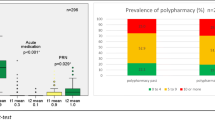Abstract
Pharmacological treatment in end-of-life care should focus on minimizing symptoms and relieving suffering. Therefore, the continued use of chronic medications for co-morbid conditions should be evaluated on an individualized basis.
Similar content being viewed by others
References
van Nordennen RT, Lavrijsen JC, Vissers KC, et al. Decision making about change of medication for comorbid disease at the end of life: an integrative review. Drugs Aging. 2014;31(7):501–12.
Van Mechelen W, Aertgeerts B, De Ceulaer K, et al. Defining the palliative care patient: a systematic review. Palliat Med. 2013;27(3):197–208.
Koh NY, Koo WH. Polypharmacy in palliative care: can it be reduced? Singapore Med J. 2002;43(6):279–83.
Sepulveda C, Marlin A, Yoshida T, et al. Palliative care: the World Health Organization’s global perspective. J Pain Symptom Manag. 2002;24(2):91–6.
Riechelmann RP, Krzyzanowska MK, Zimmermann C. Futile medication use in terminally ill cancer patients. Support Care Cancer. 2009;17(6):745–8.
McLean S, Sheehy-Skeffington B, O’Leary N, et al. Pharmacological management of co-morbid conditions at the end of life: is less more? Ir J Med Sci. 2012;182(1):107–12.
Silveira MJ, Kazanis AS, Shevrin MP. Statins in the last six months of life: a recognizable, life-limiting condition does not decrease their use. J Palliat Med. 2008;11(5):685–93.
Bayliss EA, Bronsert MR, Reifler LM, et al. Statin prescribing patterns in a cohort of cancer patients with poor prognosis. J Palliat Med. 2013;16(4):412–8.
Currow DC, Stevenson JP, Abernethy AP, et al. Prescribing in palliative care as death approaches. J Am Geriatr Soc. 2007;55(4):590–5.
Parsons C, Hughes CM, Passmore AP, et al. Withholding, discontinuing and withdrawing medications in dementia patients at the end of life: a neglected problem in the disadvantaged dying? Drugs Aging. 2010;27(6):435–49.
Stevenson J, Abernethy AP, Miller C, et al. Managing comorbidities in patients at the end of life. BMJ. 2004;329(7471):909–12.
Legault S, Tierney S, Senecal I, et al. Evaluation of a thromboprophylaxis quality improvement project in a palliative care unit. J Pain Symptom Manag. 2011;41(3):503–10.
Kierner KA, Gartner V, Schwarz M, et al. Use of thromboprophylaxis in palliative care patients: a survey among experts in palliative care, oncology, intensive care, and anticoagulation. Am J Hosp Palliat Care. 2008;25(2):127–31.
Gillon S, Noble S, Ward J, et al. Primary thromboprophylaxis for hospice inpatients: who needs it? Palliat Med. 2011;25(7):701–5.
Soto-Cardenas MJ, Pelayo-Garcia G, Rodriguez-Camacho A, et al. Venous thromboembolism in patients with advanced cancer under palliative care: additional risk factors, primary/secondary prophylaxis and complications observed under normal clinical practice. Palliat Med. 2008;22(8):965–8.
Tran QN. Role of palliative low-molecular-weight heparin for treating venous thromboembolism in patients with advanced cancer. Am J Hosp Palliat Care. 2010;27(6):416–9.
Spiess JL. Can I stop the warfarin? A review of the risks and benefits of discontinuing anticoagulation. J Palliat Med. 2009;12(1):83–7.
Angelo M, Ruchalski C, Sproge BJ. An approach to diabetes mellitus in hospice and palliative medicine. J Palliat Med. 2011;14(1):83–7.
Vandenhaute V. Palliative care and type II diabetes: a need for new guidelines? Am J Hosp Palliat Care. 2010;27(7):444–5.
Ford-Dunn S, Smith A, Quin J. Management of diabetes during the last days of life: attitudes of consultant diabetologists and consultant palliative care physicians in the UK. Palliat Med. 2006;20(3):197–203.
Tice MA. Diabetes management at the end of life: transitioning from tight glycemic control to comfort. Home Healthc Nurse. 2006;24(5):290–3.
Stiel S, Krumm N, Pestinger M, et al. Antibiotics in palliative medicine: results from a prospective epidemiological investigation from the HOPE survey. Support Care Cancer. 2012;20(2):325–33.
Lam PT, Chan KS, Tse CY, et al. Retrospective analysis of antibiotic use and survival in advanced cancer patients with infections. J Pain Symptom Manag. 2005;30(6):536–43.
Enck RE. Antibiotic use in end-of-life care: a soft line? Am J Hosp Palliat Care. 2010;27(4):237–8.
Oh DY, Kim JH, Kim DW, et al. Antibiotic use during the last days of life in cancer patients. Eur J Cancer Care (Engl). 2006;15(1):74–9.
Hippisley-Cox J, Coupland C. Unintended effects of statins in men and women in England and Wales: population based cohort study using the QResearch database. BMJ. 2010;340:c2197.
Vollrath AM, Sinclair C, Hallenbeck J. Discontinuing cardiovascular medications at the end of life: lipid-lowering agents. J Palliat Med. 2005;8(4):876–81.
Disclosure
This article was adapted from Drugs & Aging 2014:31(7):501-12 [1] by salaried/contracted employees of Adis/Springer. The preparation of these articles was not supported by any external funding.
Author information
Authors and Affiliations
Consortia
Rights and permissions
About this article
Cite this article
Adis Medical Writers. In patients receiving end-of-life care, medications used to treat co-morbid diseases should be discontinued when appropriate. Drugs Ther Perspect 30, 432–434 (2014). https://doi.org/10.1007/s40267-014-0153-1
Published:
Issue Date:
DOI: https://doi.org/10.1007/s40267-014-0153-1



